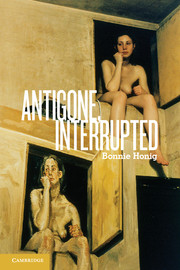Book contents
- Frontmatter
- Contents
- Preface
- Acknowledgments
- Introduction
- Part I Interruption
- Part II Conspiracy
- 4 Mourning, membership, and the politics of exception: plotting Creon's conspiracy with democracy
- 5 From lamentation to logos: Antigone’s conspiracy with language
- 6 Sacrifice, sorority, integrity: Antigone's conspiracy with Ismene
- Conclusion
- About the Cover Image
- Notes
- Bibliography
- Index
About the Cover Image
Published online by Cambridge University Press: 05 May 2013
- Frontmatter
- Contents
- Preface
- Acknowledgments
- Introduction
- Part I Interruption
- Part II Conspiracy
- 4 Mourning, membership, and the politics of exception: plotting Creon's conspiracy with democracy
- 5 From lamentation to logos: Antigone’s conspiracy with language
- 6 Sacrifice, sorority, integrity: Antigone's conspiracy with Ismene
- Conclusion
- About the Cover Image
- Notes
- Bibliography
- Index
Summary
Girl Sitting in the Attic Doorway (1995) is a Lucian Freud painting of Nicola Bateman around the time that her husband, Leigh Bowery, died of AIDS. The image on the cover of this book is a photograph of that painting sitting on Freud's easel, with the woman posing for the painting visible in the upper right corner of the photograph.
The photograph, by Bruce Bernard, is of the scene of painting. Depicting the painting and its subject, the picture highlights the differences between them, accenting the interpretative powers of the painter, and seeming to let the photograph speak for itself. (This is the conceit of photography.) The painter's easel, visible in the photo, calls attention to the painterliness of the lower painted image, by contrast with the photographed image of the painting's model in the upper corner. Enacting a reception of Freud's work, depicting a woman in mourning, reflecting on the powers of media and representation, trafficking in tropes of doubling and, ironically, instancing the legacies of father/son or intergenerational inheritance (Lucian Freud is a grandson of Sigmund Freud, the so-called "father" of psychoanalysis), Bernard's photograph connects, almost uncannily, with many of this book's central themes.
- Type
- Chapter
- Information
- Antigone, Interrupted , pp. 198 - 200Publisher: Cambridge University PressPrint publication year: 2013

